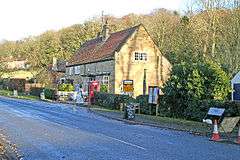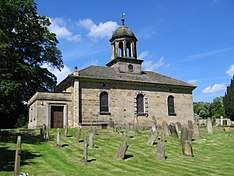Brandsby
Brandsby is a village in North Yorkshire, England. The village is the main constituent of the Brandsby-cum-Stearsby Civil Parish in the District of Hambleton. The village is mentioned in the Domesday book. It lies between Easingwold and Hovingham, some 12.3 miles (19.8 km) north of York.
| Brandsby | |
|---|---|
 Brandsby | |
 Brandsby Location within North Yorkshire | |
| Population | 234 |
| OS grid reference | SE5872 |
| District | |
| Shire county | |
| Region | |
| Country | England |
| Sovereign state | United Kingdom |
| Post town | YORK |
| Postcode district | YO61 |
| Police | North Yorkshire |
| Fire | North Yorkshire |
| Ambulance | Yorkshire |
| UK Parliament | |
History
The village toponymy is of Scandinavian origin named after a Norseman called Brand and the suffix of by meaning settlement or habitation. At the time of the Norman conquest, it was held by Cnut, son of Karli and afterwards by Hugh, son of Baldric. Later the village and the surrounding lands were given to Baron Roger de Mowbray. It was part of the Bulford Hundred. The Baron left the lordship of the manor to Nicholas de Riparia (or de le Ryver), whose family held it until the reign of Queen Elizabeth I. After this the Lordship passed via marriage to the Cholmeley family, descended from the Cholmondeley family of Cheshire.[1] The lordship ended with the last of the Cholmeley family, Hugh Charles Fairfax Cholmeley, who died in 1940.[2]
During the 13th and 14th centuries, Brandsby was the production centre for the Brandsby-type ware of Medieval ceramic.[3]
The village was also the site for the York 37 Royal Observer Corps Post (Brandsby). The Nuclear Monitoring Post is located on the road between the village and Crayke at Zion Hill Farm. It was part of the York No' 20 Group ROC HQ and was opened in June 1964 and closed in September 1991. It is now a Grade II Listed building and although the Post had been restored the restorer has allegedly been evicted due to getting the Post listed against the farmers wishes. The Post website has been taken over by a company selling sunglasses.[4][5][6]
Governance
The village lies within the UK parliamentary constituency of Thirsk and Malton. It is part of the Stillington, North Yorkshire electoral division of North Yorkshire County Council. It is also in the Stillington ward of Hambleton District Council.[7] The Parish Council is made of five councillors including the Chair.[8]
Geography
The village is situated near the Howardian Hills, south of the North York Moors. At the latter end of the nineteenth century, the population was around 300,[1] which has fallen to 234 according to the 2001 UK Census. There are 117 dwellings in the parish. Of the total population, 202 are over the age of sixteen, of which 115 are in employment.[9]
On the west side of the village is Brandsby Beck, which flows into the River Foss. The nearest settlements are Yearsley, 1.27 miles (2.04 km) to the north; Stearsby, 1.5 miles (2.4 km) to the west-south-west; Stillington, 2.9 miles (4.7 km) to the south and Crayke, 2 miles (3.2 km) to the south-west.[7] The B1363 road between York and Oswaldkirk passes through the village.
The soil in the parish is made of sand and gravel on top of Lias and Oolite.[10]
Education
The village lies within the Northallerton Local Education Authority area. The nearest Primary education can be found in either Crayke or Stillington.[11] Secondary education is provided in Easingwold.[12]
Religion

There is one church in the village, dedicated to All Saints, situated in what used to be the grounds of Brandsby Hall. It was built to replace the old church by the York architect Thomas Atkinson for Francis Cholmeley of Brandsby Hall in 1770.[1] It was restored by the London architect Temple Lushington Moore in 1905 and is a Grade II* listed building.[13]
Notable landmarks
Brandsby Hall was constructed to an Italianate design for Francis Cholmeley in 1745 on the site of an old mansion. It is built of sandstone in 3 storeys to a U-shaped plan, with a 7-bay frontage. It is a Grade II* listed building. The chapel on the grounds is now the village church.[1][14]
The Old Rectory dates from 1565 and was built by the incumbent, Robert Wilson. It was remodelled by the then rector, Walter Smith, in 1807. It is also listed Grade II*.[15]
Cherry Hill is an arts and crafts country house, designed in 1909 by Fred Rowntree.
References
- Bulmer's Topography, History and Directory (Private and Commercial) of North Yorkshire 1890. S&N Publishing. 1890. p. 653. ISBN 1-86150-299-0.
- "Lord of the Manor". Archived from the original on 9 February 2015. Retrieved 11 November 2012.
- Jennings, S. 1992. Medieval Pottery in the Yorkshire Museum, York, 18-21.
- "Bransdby ROC Post". Archived from the original on 30 April 2013. Retrieved 19 January 2013.
- "ROC Posts". Retrieved 19 January 2013.
- "Listed status". Retrieved 19 January 2013.
- Ordnance Survey Open View Archived 2012-10-05 at the Wayback Machine
- "Parish Council". Retrieved 11 November 2012.
- "Census data". Retrieved 11 November 2012.
- "Geology". Retrieved 11 November 2012.
- "Schools". Archived from the original on 16 February 2013. Retrieved 11 November 2012.
- "Secondary Schools". Archived from the original on 2 December 2011. Retrieved 11 November 2012.
- Historic England. "CHURCH OF ALL SAINTS (1150750)". National Heritage List for England. Retrieved 8 December 2013.
- "Listed status". Retrieved 11 November 2012.
- "Listed status". Retrieved 11 November 2012.